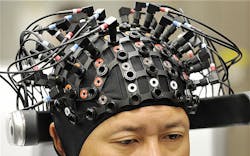Researchers look to Rice University for nonsurgical brain interfaces to control weapons and computers
ARLINGTON, Va. – U.S. military researchers are moving forward with a project to develop non-invasive or minimally invasive neural interfaces to connect the brains of warfighters to computers or other digital devices to enable fast, effective, and intuitive hands-free interaction with military systems.
Officials of the U.S. Defense Advanced Research Projects Agency (DARPA) in Arlington, Va., announced a $9.8 million order Rice University in Houston on Monday for the Next-Generation Nonsurgical Neurotechnology (N3) program.
Rice University was one of six organizations awarded N3 contracts in May 2019 to develop non-surgical wearable interfaces to connect human brains with computers for tasks like control of active cyber defense systems and swarms of unmanned aerial vehicles, or teaming with computer systems to multitask during complex missions.
Rice University has been working on a minutely invasive, bidirectional system for recording from and writing to the brain. An interface records by using diffuse optical tomography to infer neural activity by measuring light scattering in neural tissue. It writes with a magneto-genetic approach to make neurons sensitive to magnetic fields.
This week's contract asks Rice researchers to continue with their work in developing a high resolution neural interface that does not require surgery.
Neural interfaces could enable warfighters to multitask more efficiently, and interact with autonomous and semi-autonomous systems -- particularly future systems equipped with artificial intelligence (AI), researchers say.
The original N3 contractors, in addition to Rice University, are Battelle Memorial Institute in Columbus, Ohio; Carnegie Mellon University in Pittsburgh; Johns Hopkins University Applied Physics Laboratory in Laurel, Md.; Palo Alto Research Center (PARC) in Palo Alto, Calif.; and Teledyne Technologies in Thousand Oaks, Calif.
The DARPA N3 project seeks to develop a nonsurgical neural interface system to broaden the applicability of neural interfaces to the able-bodied warfighter.
Until now, neural interfaces that connect human brains to computers and other digital equipment have been surgically invasive and used primarily to help restore functions and skills to injured warfighters. The N3 project, however, seeks to enable neural recording and stimulation with sub-millimeter spatial resolution in healthy warfighters.
The problem with human-machine neural interfaces today is how surgically invasive they are. State-of-the-art high-resolution single-neuron or neural-ensemble neural interfaces are invasive, and require surgical implantation of metal or silicon-based electrodes into brain tissue or on the surface of the brain.
The burden of surgery and associated risks are too high for this approach on able-bodied individuals. The N3 program aims to overcome these issues by developing a nonsurgical neural interface that is safe for human use, and that has high spatiotemporal resolution and low latency to enable function on par with current microelectrode technology.
DARPA wants the interface to be bidirectional and integrate technology for neural recording (read out) and neural stimulation (write in), and should be agnostic to military systems that would use it.
This neural interface either will be completely external to the body or will include a non surgically delivered nanotransducer that will serve as a signal transducing intermediary between neurons and the external recording and stimulating device.
The major technological challenge of the DARPA N3 project is to interact with neural tissue through the skull while maintaining high spatial and temporal resolution, using either a non invasive interface or minutely invasive interface, DARPA officials say.
Non invasive interfaces will involve sensors and stimulators that do not breach the skin. Minutely invasive approaches, meanwhile, will permit nonsurgical delivery of a nanotransducer delivered to neurons of interest.
Transducers should be small enough so as not to cause tissue damage or impede the natural neuronal circuit, and will be external to the skull. Non invasive and minutely invasive approaches will be necessary to overcome issues with signal scattering, attenuation, and signal-to-noise ratio.
The N3 program includes a computational and processing unit that must provide decoded neural signals for control in a military application. It must also provide the capability to encode signals from a military application and deliver sensory feedback to the brain.
The N3 program will provide funding at least through 2023 to deliver a nonsurgical neural interface system and is divided into three sequential phases: a one-year base effort, and two 18-month option periods.
On this order Rice University experts will do the work in Houston and Waco, Texas; New York City; New Haven, Conn.; and Durham, N.C., and should be finished by May 2022. For more information contact Rice University online at https://news.rice.edu, or DARPA at www.darpa.mil.
About the Author
John Keller
Editor-in-Chief
John Keller is the Editor-in-Chief, Military & Aerospace Electronics Magazine--provides extensive coverage and analysis of enabling electronics and optoelectronic technologies in military, space and commercial aviation applications. John has been a member of the Military & Aerospace Electronics staff since 1989 and chief editor since 1995.
